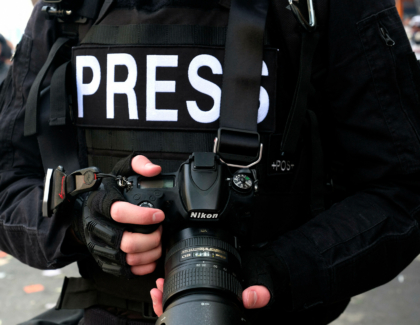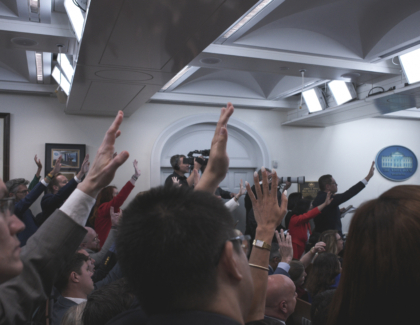Sign up for the daily CJR newsletter.
For weeks it has been nearly impossible for viewers in the Minneapolis area to watch a single episode of Family Feud without seeing an ad for Michael Bloomberg. It is one of many programs with a larger-than-average share of black viewers on which Bloomberg has bought advertising through his unprecedented television marketing campaign.
The mountain of TV ad cash is both a bid to bypass mediators like the press and the party machine, and a huge financial boon to local newsrooms across the country, where station-level advertising is a primary source of income.
The Tow Center has accounted for about $9 million of the more than $258 million Bloomberg is spending on television advertising through Assembly, his Manhattan advertising firm. We have done this by compiling invoices sent to Assembly by the Sinclair Broadcasting Group, the largest station operator in the US. Invoices, orders, and signed statements about candidacy are all submitted to the Federal Communications Commission’s website, which maintains a public inspection file for every licensed broadcaster in the US. Our data goes from the beginning of the 2020 campaign season to February 23.
The site is slow to load and the files themselves are a mess: some invoices are submitted to the system more than once; some aren’t submitted in full; some stations had a number of orders, but hadn’t uploaded any invoices at all. Many had uploaded grainy faxes; in one case, WVTV, the Milwaukee CW affiliate, sent in sideways cell phone photos of a contract sitting on a desk.
After weeks of whittling down the thousands of available files for the Bloomberg campaign to a manageable subset of useful data, we can come to some conclusions about the campaign. We hope to iterate this process as the election continues in order to provide greater insight into the nexus of campaign finance and the media, and to form a basis for closer examination of these files in the future.
Bloomberg’s campaign is unique not just for the depths of the candidate’s pockets but also for how it spends his money. As far as we can tell, Bloomberg is working exclusively through Assembly, and does not have the support of any of the financial instruments—PACs, super PACs, trade organizations—that often emerge to back a candidate who represents their interests.
He’s spending his own money, and by law, candidates are entitled to the lowest rate on every ad. (“Dark money” organizations, by contrast, would pay whatever the market would bear.) Thus, a significant percentage of the advertisements he’s buying are being sold to him for a few dollars apiece. In examining over 2,500 PDF files, we found orders for single advertisements in amounts of eight and nine dollars.
The effect of the low prices to which Bloomberg is entitled and the vast sum of money at his disposal effectively enables him to be on every broadcast or syndicated show where he cares to appear, on every broadcast network, at any time he cares to be there. Elizabeth Warren’s much-criticized super PAC spent $3 million on television advertisements in Super Tuesday states across the country, according to Politico; according to our research, Bloomberg personally spent $1.7 million at WSB, a single ABC affiliate in Atlanta, where polls open March 24.
For researchers, at least, Bloomberg’s campaign is on Easy Mode: His ad buys are under his own name and not obscured as “non-candidate issue ads” purchased by shadowy committees with anodyne names. We can see that he has sought out shows that appeal to black viewers, especially ABC sitcoms Black-ish and Mixed-ish, and the game show Family Feud. We can also see where his campaign has concentrated its purchasing power on Sinclair-managed stations (in central California, Alabama, Texas, North Carolina, Tennessee, and Minnesota), as well as further down the road (to his bids for Michigan and Washington state).
For television networks, this is a mixed blessing—or perhaps an unmixed one, if you’re sufficiently cynical. Now is the time when television stations in swing states store up their nuts for the winter. Ad dollars come pouring into their coffers for months; since Citizens United, it’s been a good time to add staff or buy equipment. Bloomberg’s campaign gives this dynamic a boost. “We have received payment for this week,” reads one frustrated email from a Sinclair finance employee attached to a Birmingham, Alabama order. “I do not have a breakdown of how much for each station as they sent over $900,000.”
Ad prices in these markets are also a measure of the vast gap between the media in the Acela corridor and the interests of the rest of the country. Bloomberg paid $21,000 for a single thirty-second spot on one Atlanta-based ABC affiliate during the Citrus Bowl, where Alabama and Michigan faced off in a football game that the national media largely ignored. Local stations’ Super Bowl ads were in the low thousands of dollars, by comparison.
Why TV?
Buying television ads from individual, over-the-air broadcast stations around the country is a time-honored method of geotargeting—advertising narrowly to people living in a specific region of an enormous, populous country. The designated market areas (DMAs) representing the stations’ geographic reach are treacherous: They cross state lines, wander into halves and thirds of municipal regions, and are numbered based on population, which changes—slightly—every year.
Broadcast TV that comes in over an old-fashioned rabbit-ears antenna skews toward the elderly and is disproportionately viewed by people of color; both correspond to the most reliable sector of the Democratic electorate. With a narrowly targeted ad buy, a media agency like Assembly might reasonably expect to reach much of the black electorate in Fresno, or the majority of Spanish-speaking Alabama voters over 50. In a Democratic primary where the electorate is a much smaller group of people than in a general election, narrow voting blocs like these are vital to any successful campaign.
Sinclair owns affiliates of the four major English-language networks (ABC, NBC, CBS, and Fox), as well as smaller networks like The CW, MyNetwork TV, and Heroes & Icons, and Spanish-language networks like Azteca, Telemundo, and Univision. It has holdings in 34 states.
But Sinclair is interesting beyond its size. It has been the subject of criticism from journalists for its use of “must-run” segments parroting Trump talking points, which its local anchors are required to read. Within the industry, Sinclair has courted controversy by using “local marketing agreements” with other station owners to circumvent laws that limit station ownership. As a result, Sinclair-owned stations are ubiquitous through much of the South—the most populous region in the US, and one that has always been vital to Democratic nominee hopefuls.
Super Tuesday is the first day of Bloomberg’s campaign, regardless of what you might have heard about his debate performance or read in the assorted shellackings from columnists and opponents. The ninth-richest man on earth has spent millions upon millions of his own dollars to acquire the Democratic nomination, all of which is focused on states that begin voting today. The half-billion or so he has spent so far dwarfs the expenditures of his rivals, and more than half of that sum has been spent on television advertising, according to his most recent FEC filing. He is trying hard to buy the nomination; tomorrow, we will have a better idea of what it is he actually bought.
Has America ever needed a media defender more than now? Help us by joining CJR today.







